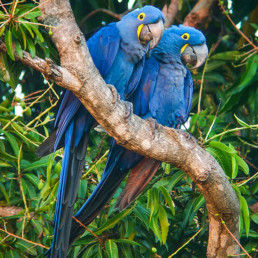Vulnerable
The Hyacinth Macaw is the world’s largest macaw species, and it is made even more magnificent by its deep cobalt blue plumage, large black beak and striking yellow facial highlights. Like many macaw species, it has disappeared from much of its range at the hands of the illegal pet trade. Now with a shrinking breeding range, some still enjoy refuge where the East Amazonian rainforest and drier palm savanna meet on the Xingu River in the heart of Kayapo territory. Like many macaws it is dependent on a few distinct types of palm fruit, which its massive bill is adapted to opening. However, the sloppy eating by macaws aids in seed dispersal of 18 species of plants and trees and thus planting new sources of food for themselves, often far from where the fruit was plucked.

Blue Majesty
The Hyacinth Macaw is enormous with its 100cm (40 in) length and wingspan, and body weight of 1.5 kg (3.5 pounds). The entire bird is bright, cobalt blue, with showy yellow eye-rings and a strip of yellow at the base of its lower mandible. Equally impressive are it very loud croaking and screeching calls.
Hyacinth Macaws pair for life and the mates are in constant physical and vocal contact. To nest they must find a natural cavity in a tree, and because of their great size the tree must also be immense. With large trees targeted by loggers, it is no surprise that this is another factor in their declines. Unlike many nesting bird’s chicks, capable of flight in 2 to 3 weeks, this macaw’s young needs a steady diet rich in protein (palm nuts) for over 3 months before they have matured enough to fledge and leave the nest.
Unlike many macaws that dwell in rainforest habitats, the Hyacinth Macaw prefers large, flooded palm swamps with patches of gallery forest. The Pantanal of the southwestern Brazil is comprised of just that, and is the stronghold for this species.

Recognized as an avian marvel, this species contributes to the pollination of native flora and plays a vital part in maintaining biodiversity. Its charismatic presence and distinctive behaviors make it an essential component of the intricate balance of its habitat.

